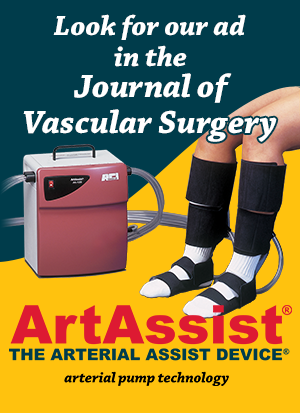Lower limb ischemia caused by Peripheral Arterial Disease is a hot topic in medicine. Intermittent pneumatic compression therapy is being used to treat patients with ischemic limbs where conventional treatments (namely surgery) fail or cannot be used.
If you are interested in learning more about arterial pneumatic compression pump therapy to treat ischemic ulcers, ACI Medical encourages you to explore the growing research surrounding the ArtAssist® device.
The latest research comes from a presentation at the Society of Vascular Surgery Annual Meeting in June 2015. Excerpt from abstract:
Enhancing Neovascularization in Chronic Limb-Threatening Ischemia
Objectives: The shear stress stimulus needed to switch on arteriogenesis, attenuated in chronic limb-threatening ischemia (CLI), can be restored with intermittent pneumatic compression (IPC). IPC also increases inflow of
oxygenated nutritive blood, clears waste products of metabolism, and enhances the traffic of elements needed for neovascularization (NV). The circulating progenitor cell (CPC) population is also depressed in CLI. We hypothesize that NV will be promoted by IPC and CPC mobilization.
Additional research begins to explore the effect of leg IPC on nitric oxide (NO) levels in the arm. Excerpt from abstract:
The effect of intermittent pneumatic compression of legs on the levels of nitric oxide related species in blood and on arterial function in the arm
Background: Intermittent pneumatic compression (IPC) of legs exerts beneficial local vascular effects, possibly through local release of nitric oxide (NO). However, studies demonstrating systemic transport of nitrogen oxide species and release of NO prompt the question of whether IPC could also exert nonlocal effects. We tested whether IPC (1) affects systemic levels of nitrite, S-nitrosothiols and red blood cell (RBC) NO, and (2) exerts vasoactive effects in the brachial artery (BA), although this hypothesis-generating pilot study did not investigate cause and effect relationship between (1) and (2).
Additional studies surrounding the treatment of lower limb ischemia with IPC can be found on the Clinical Studies page under the Limb Salvage & CLI heading.
Contact ACI Medical to discuss all aspects of arterial IPC treatment, from ongoing research to how patients can easily obtain the ArtAssist® device for home use:
Toll Free (888) 453-4356 or info@acimedical.com













